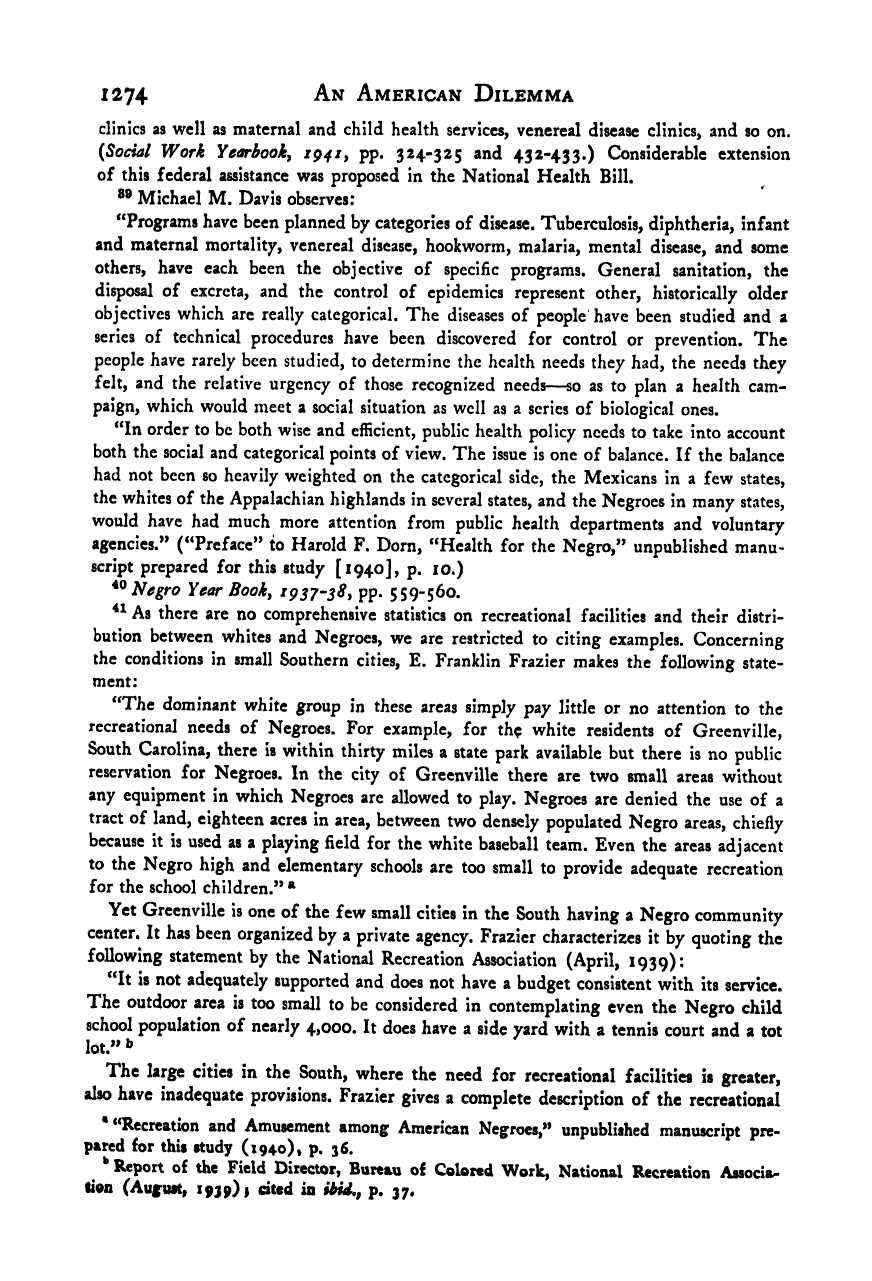Note: Gunnar Myrdal died in 1987, less than 70 years ago. Therefore, this work is protected by copyright, restricting your legal rights to reproduce it. However, you are welcome to view it on screen, as you do now. Read more about copyright.
Full resolution (TIFF) - On this page / på denna sida - Footnotes - Chapter 15

<< prev. page << föreg. sida << >> nästa sida >> next page >>
Below is the raw OCR text
from the above scanned image.
Do you see an error? Proofread the page now!
Här nedan syns maskintolkade texten från faksimilbilden ovan.
Ser du något fel? Korrekturläs sidan nu!
This page has never been proofread. / Denna sida har aldrig korrekturlästs.
1274 An American Dilemma
clinics as well as maternal and child health services, venereal disease clinics, and so on.
{Social Work Yearbook^ pp. 324-325 and 432-433.) Considerable extension
of this federal assistance was proposed in the National Health Bill.
Michael M. Davis observes:
“Programs have been planned by categories of disease. Tuberculosis, diphtheria, infant
and maternal mortality, venereal disease, hookworm, malaria, mental disease, and some
others, have each been the objective of specific programs. General sanitation, the
disposal of excreta, and the control of epidemics represent other, historically older
objectives which are really categorical. The diseases of people have been studied and a
series of technical procedures have been discovered for control or prevention. The
people have rarely been studied, to determine the health needs they had, the needs they
felt, and the relative urgency of those recognized needs—so as to plan a health cam-
paign, which would meet a social situation as well as a scries of biological ones.
“In order to be both wise and efficient, public health policy needs to take into account
both the social and categorical points of view. The issue is one of balance. If the balance
had not been so heavily weighted on the categorical side, the Mexicans in a few states,
the whites of the Appalachian highlands in several states, and the Negroes in many states,
would have had much more attention from public health departments and voluntary
agencies.” (“Preface” to Harold F. Dorn, “Health for the Negro,” unpublished manu-
script prepared for this study [1940], p. 10.)
Negro Year Booky 19 37-38
y
pp. 559-560.
As there are no comprehensive statistics on recreational facilities and their distri-
bution between whites and Negroes, we are restricted to citing examples. Concerning
the conditions in small Southern cities, E. Franklin Frazier makes the following state-
ment;
“The dominant white group in these areas simply pay little or no attention to the
recreational needs of Negroes. For example, for thp white residents of Greenville,
South Carolina, there is within thirty miles a state park available but there is no public
reservation for Negroes. In the city of Greenville there are two small areas without
any equipment in which Negroes are allowed to play. Negroes are denied the use of a
tract of land, eighteen acres in area, between two densely populated Negro areas, chiefly
because it is used as a playing field for the white baseball team. Even the areas adjacent
to the Negro high and elementary schools are too small to provide adequate recreation
for the school children.”*
Yet Greenville is one of the few small cities in the South having a Negro community
center. It has been organized by a private agency. Frazier characterizes it by quoting the
following statement by the National Recreation Association (April, 1939):
“It is not adequately supported and does not have a budget consistent with its service.
The outdoor area is too small to be considered in contemplating even the Negro child
school population of nearly 4,000. It does have a side yard with a tennis court and a tot
lot.”
The large cities in the South, where the need for recreational facilities is greater,
also have inadequate provisions. Frazier gives a complete description of the recreational
<< prev. page << föreg. sida << >> nästa sida >> next page >>